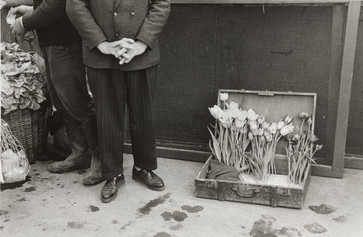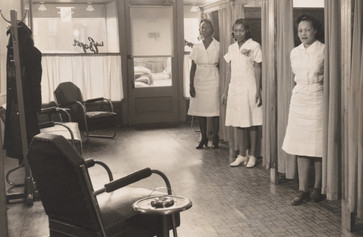August Sander’s Life Studies
Looking at a photograph from People of the Twentieth Century
Alex Halberstadt
Oct 23, 2019
![August Sander, Mother and Son [Lou Straus-Ernst with son Jimmy]. 1928](/d/assets/W1siZiIsIjIwMTkvMTAvMjIvNnA5dTBqaG1heF80NzJfMjAxNV8xOTZfUklDUl9GdWxsX3NpemVfSlBFRy5qcGciXSxbInAiLCJjb252ZXJ0IiwiLXF1YWxpdHkgOTAgLXJlc2l6ZSAxMTg0eDg4OFx1MDAzZSJdXQ/472_2015_196_RICR-Full_size_JPEG.jpg?sha=91b8b00a7f4d0d08)
August Sander, Mother and Son [Lou Straus-Ernst with son Jimmy]. 1928
The fourth session of The August Sander Project—a five-year exploration of Sander’s *People of the Twentieth Century*—convened on September 13, 2019, at Columbia University.
A mother and her son sit on a bench in a photographer’s studio. We can suss out their relationship without the aid of a caption—they share the same dark eyes, which are fixed on the photographer’s lens. She holds him protectively, her left arm wrapped around his shoulders, her right hand holding his in her lap—that’s what the eye returns to. The gesture is anxious, informed by some presentiment of loss and made more stark by the boy’s placid expression. The closer you look, the more there is to see—the woman’s sleeveless dress and the boy’s vividly white shirt and short pants tell us it’s summer; there’s his grosgrain belt, and the white carnation pinned to her collar with a silver brooch. This photograph was taken by August Sander in 1928 for People of the Twentieth Century, his monumental visual atlas that attempted to classify German society according to social type and profession. But in its accumulation of detail and psychological acuity, the image allows mother and son to slip loose from their taxonomic nook and begin to inspire questions. That’s one mark of a great portrait—the way its subjects spawn narratives in the viewer’s imagination. Who was this woman? What does her gesture mean? What must it have been like to be her?
We continue to look at Sander’s images not because of the vast scale of his nearly lifelong project—photography’s *Leaves of Grass*—but because of his uncanny talent for portraiture. What distinguishes his photos are their ability, as Glenn Gould said about Bach’s fugues, to provoke feeling. To me, among photographers, only Robert Frank and Rineke Dijkstra equal Sander’s capacity to instill a connection between subject and viewer, to use a static image to suggest an entire life. Yet what makes Sander’s portraits nearly as engaging is the way they personalize history. Instead of textbook generalities, they furnish us with particulars; our awareness of their moment in time courses through these photographs like an electric current.
Sander’s own ideas about his work concerned physiognomy—the quixotic notion that a person’s character can be discerned in the features of their face. But Sander stretched this conceit further. “The individual does not make the history of his time, but he both impresses himself on it and expresses its meaning,” he said in a 1931 radio broadcast. “It is possible to record the historical physiognomic image of a whole generation and—with enough knowledge of physiognomy—to make that image speak in photographs.”
I don’t know about you, but to me this sounds at best like romantic mush, and at worst like a pseudoscience bordering on phrenology and eugenics. And yet Sander is also right—the photos do describe their period in remarkably egalitarian terms, placing portraits of grand dukes alongside those of chambermaids, though their narrative sweep owes little to physiognomy. It’s funny: Frank’s The Americans, another photo project that takes an entire people as its subject, abounds with signifiers of Eisenhower-era America—roadhouses, lunch counters, filling stations, political rallies—that give it its indelible look. For the most part, Sander kept Germany’s landscapes and interiors out of his formal, long-exposure portraits, but his images are just as steeped in their place and time as Frank’s.
How could they not be? Sander’s subjects were the citizens of the Weimar Republic, a society crippled by the punitive economic policies of the Versailles Treaty, its middle class erased in the early 1920s by disastrous hyperinflation and, by that decade’s end, plunged into joblessness and poverty by the onset of a global depression. Many of Sander’s portraits embody these bleak realities, none more than those in People Who Came to My Door, a portfolio documenting beggars, peddlers, and the unemployed—unlucky strangers whom Sander convinced to pose for him. But the period’s imprint can be seen in the faces of the cleaning women and porters, the foreign workers and Romani musicians, and in a photo that always leaves me staring and awed—a strangely beautiful portrait of a Turkish mousetrap salesman (read the title in German: Türkischer Mäusefallenverkäufer!)
Our awareness of their moment in time courses through these photographs like an electric current.
By the late 1920s, Germany was losing patience with moderate politicians and representative democracy, sliding gradually but irrevocably into bigotry, superstition, and autocracy. The country it became is documented most obviously in Sander’s images of National Socialists—somehow more terrifying than the musclebound young Arians are the nearsighted, paunchy middle managers, wedding rings glittering on their folded hands. And how should we feel about the freckle-faced boy with the Nazi eagle on his tunic, looking no older than 14, identified as an officer trainee and photographed in 1944, with the war nearly lost?
A portfolio of political prisoners is even more unsettling. It stands out for its multiple portraits of the same subjects, as though the repeated exposures could prevent them from disappearing. They were made by Sander’s eldest son Erich while he was a political prisoner himself, having been arrested for anti-Nazi activities. His self-portrait—sitting in profile at a desk in his cell—was taken in 1943, the ninth year of his sentence. Erich died in prison a year later. And so People of the Twentieth Century, which began with group portraits of proud farmers from the Westerwald, reached its emotional peak more than three decades later with its most atypical entry: a portrait not of a person but of Erich’s death mask.
As it happens, we do know something about the mother and son in Sander’s photograph. Dr. Louise Straus-Ernst, known as Lou—an art historian, journalist, and museum director—was born to a middle-class Jewish family in Cologne. In 1918, over their objections, she married a Catholic—Max Ernst, an originator of Dada and Surrealism. The apartment the couple shared became a meeting place for friends like Kurt Weill, Hans Arp, and Sander, and a headquarters for the Cologne Dadaists. During the movement’s heyday, Strauss-Ernst exhibited several collages using the delightful name Armada von Duldgedalzen.
By the time she sat for Sander, she and Ernst were divorced; the Nazi party had outgrown its Bavarian roots and was gaining popularity across Germany. When Hitler became chancellor in 1933, she fled to Paris. The boy beside her in the photograph is her son with Ernst, Hans-Ulrich, known as Jimmy. In 1938, the year of Kristallnacht, friends helped him escape to New York; several years later he was followed there by his father and his father’s future wife, Peggy Guggenheim. Like Ernst, Jimmy would become a painter, later associated with the Abstract Expressionists. (Today MoMA’s collection includes works by both father and son.)
Hoping to be reunited with Jimmy, Lou waited for a visa from the American consulate in Marseilles; despite personal appeals to Eleanor Roosevelt, it never arrived. For a time, with other refugees, she hid out in the alpine town of Manosque, aided by the novelist Jean Giono. There she wrote a memoir that found its way to Jimmy in America, where it was published some 60 years later. In May, 1944, Straus-Ernst was arrested and taken to the transit camp for Jews in Drancy; a month later she was deported aboard the second-to-last transport to Auschwitz.
Today, looking at Sander’s portrait of Lou and Jimmy, it remains difficult to disentangle these facts from the image itself. Photography is often said to document physical reality, yet photographs rely nearly as much on what’s not in the picture—everything that has already happened, and has yet to. Where does the image end and biography begin? Is it possible to locate the boundary? In the end, this may be Sander’s main subject—things that photography can and cannot accomplish.
Alex Halberstadt’s Young Heroes of the Soviet Union, a family memoir, will be out in March.
Related articles
-

Tribute
Remembering Robert Frank, 1924–2019
MoMA curators pay tribute to an artist who changed the way we see.
Sarah Meister, Josh Siegel, Roxana Marcoci, Stuart Comer, Lucy Gallun
Sep 12, 2019
-

Tribute
Looking and Learning with Toni Morrison, 1931–2019
A curator remembers visual lessons from acclaimed writer Toni Morrison.
Sarah Meister
Aug 9, 2019

